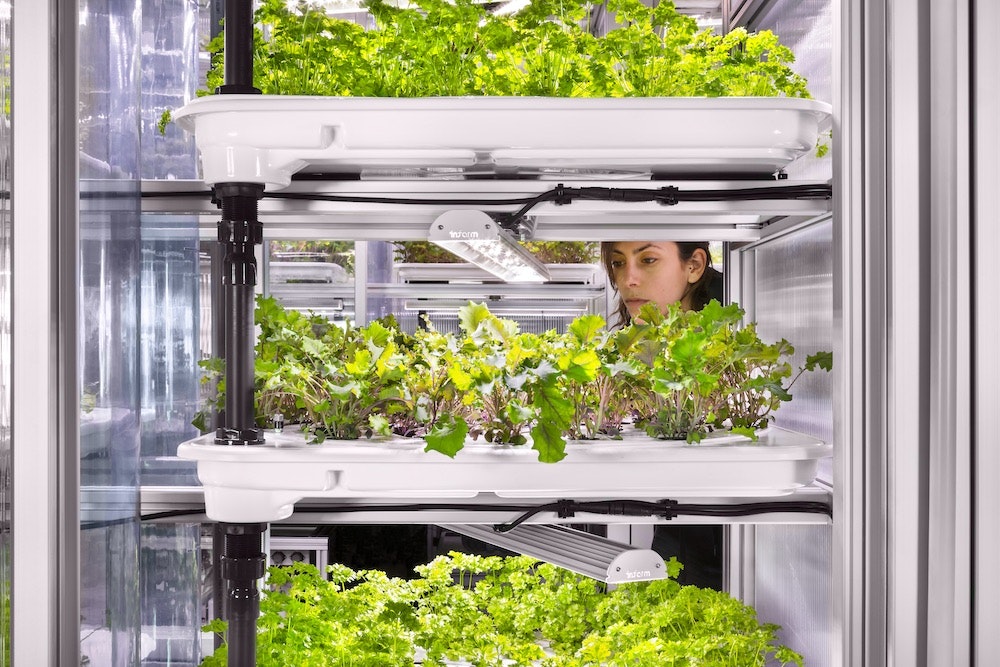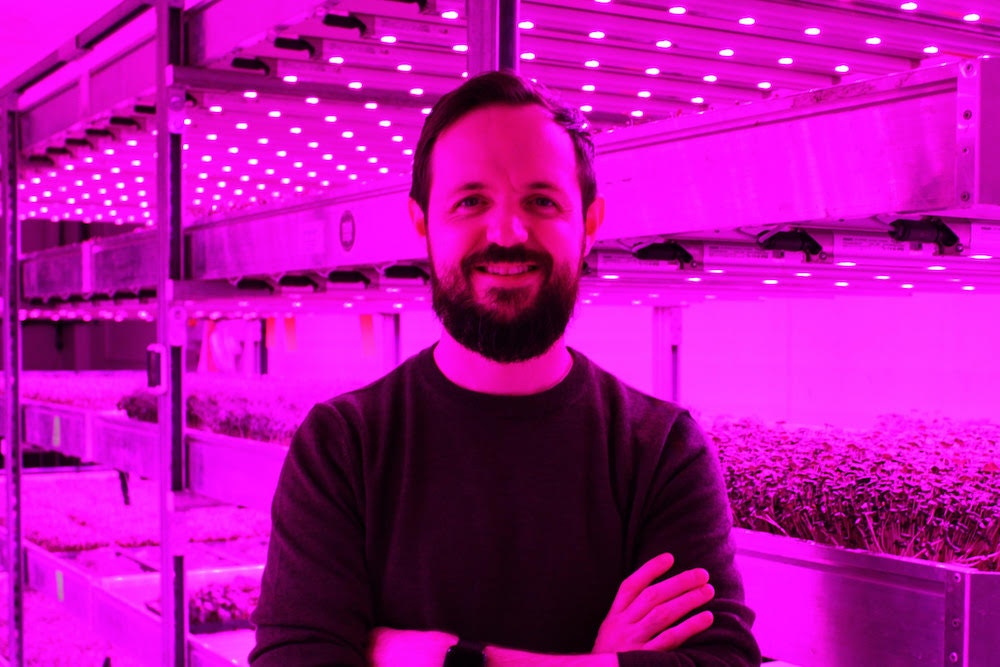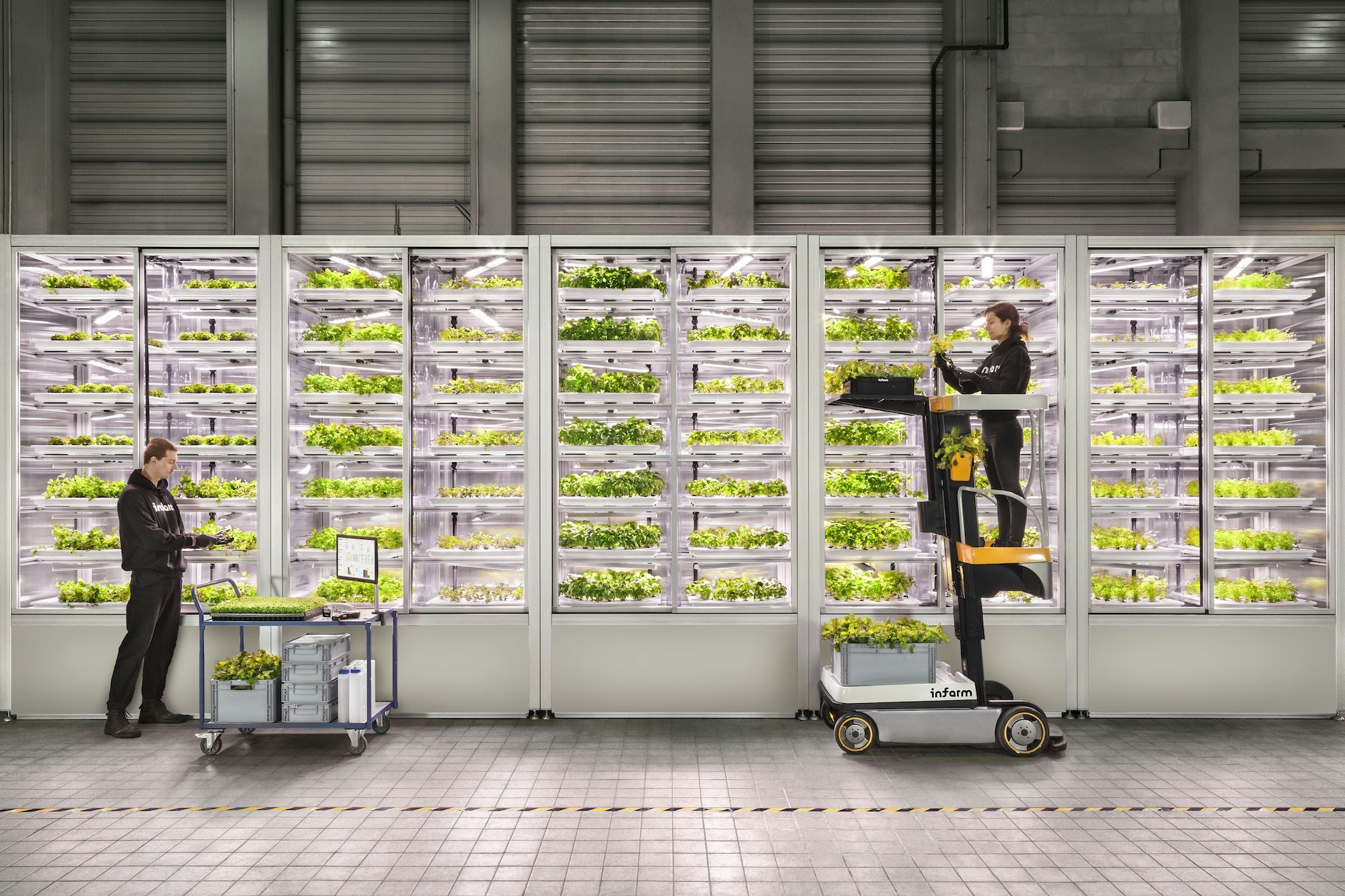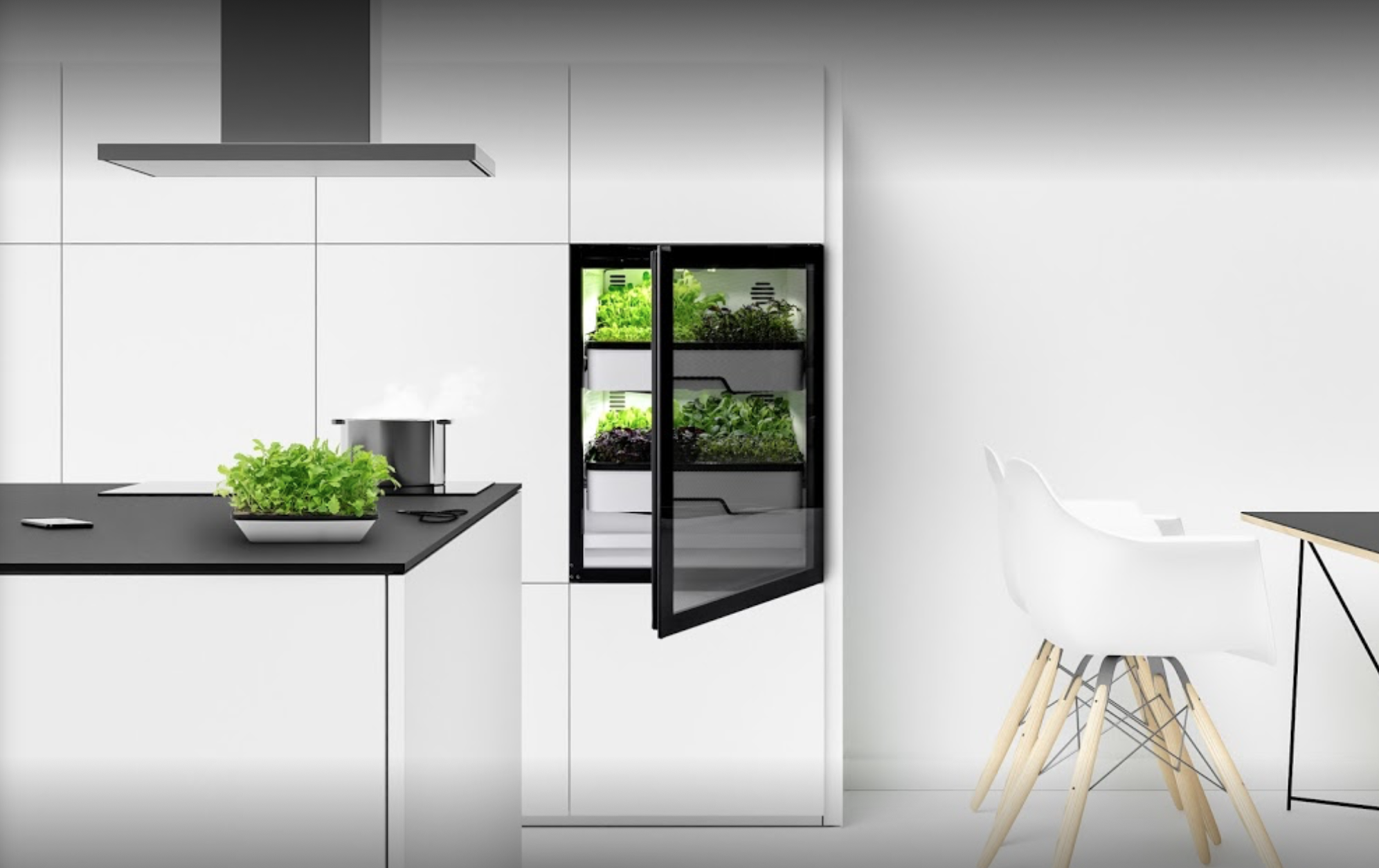In the early 20th century German scientist Fritz Haber and his colleague Carl Bosch worked out a way to synthesise ammonia, making it possible to create industrial amounts of fertiliser for the first time. It’s said that two out of five humans on the planet today owe their existence to the discovery, which led to an explosion in the amount of food the world could produce.
Today there is a new revolution going on in agriculture.
Vertical farming divorces crops from the land entirely, which is in many cases more sustainable than traditional farming and allows previously dead areas to be repurposed for growing food. All across the world, disused underground bunkers and empty shipping containers are being jazzed up with high-tech equipment — like flashy pink LEDs and environmental control sensors — to grow a new style of crop on stacked trays indoors.
This alternative process has gained a lot of attention — and money — in recent years. The global vertical farming market is expected to reach a promising $12.77bn by 2026, up from $2.23bn in 2018. Prominent European VC investors like Atomico and in the US the Footprint Coalition (Robert Downey Jr’s sustainability initiative) have jumped on the vertical farming train.
Many European startups are leading the way. Berlin-based Infarm, which builds and installs vertical farming systems for crops in supermarkets, raised $170m last month. Earlier this year, Finnish startup iFarm, which has developed a vertical farming SaaS solution, bagged a $4m funding round.
Retailers also seem enthusiastic, with online grocery supermarket Ocado recently increasing its stake in the UK vertical farming startup Jones Food Company.
There is just one problem with the vertical farming “revolution”, however. Unlike the Haber-Bosch process of fixing nitrogen to allow all crops to grow bigger and faster, vertical farming at the moment only really makes sense for a small number of expensive crops (like basil and parsley) — and that's hardly going to feed the world.
So the battle is now on to expand what vertical farming can do. Can the vertical farming pioneers pull it off? And what is getting in their way?
Why do people like vertical farming at all?

Consumer demand for organic produce has shot up in recent years, with total retail sales hitting €40.7bn in 2018, up from €26.3bn four years before. The idea of vertical farming is appealing for many who have become increasingly conscious about buying products that are sustainably produced.
So far, the usage of water, pesticides, fertilisers and herbicides have been drastically reduced in vertical farming.
Professor Leo Marcelis, the head of horticulture and product physiology at Wageningen University, and an expert in vertical farming, points out the vast water reduction capabilities of the system. “When growing tomatoes in the Mediterranean climate, you would do a very good job using 60 litres of water per kilogram of tomatoes. In the Netherlands, a regular greenhouse grower would use around 15-17 litres of water and in a vertical farm around 2-4 litres,” he tells Sifted. The European agriculture sector alone accounts for more than 50% of Europe’s total water usage.
What’s more, European startups operating vertical farms are drastically reducing resource usage. Guy Galonska, cofounder of Infarm says: “Compared to outdoor agriculture, our water usage is 90-95% more efficient, we use 70-75% less fertiliser and no pesticides, fungicides or herbicides at all.”
This is not a VC trend. “[Vertical farming] is going to have an actual impact.
On top of resource savings, vertical farming has also been recognised as a way to simplify the global food supply chain, by growing crops in urban settings. This allows products to travel a considerably shorter distance to reach supermarkets, restaurants, distribution centres and people’s homes, increasing freshness and reducing transport emissions.
And while it’s been a hotspot for investors in recent years, Galonska believes that it’s more than that: “This is not a VC trend. “[Vertical farming] is going to have an actual impact,” he tells Sifted.
The future of vertical farming seems pleasant, but there’s a catch. Some elements — like cost and energy — are weighing down the sector and threatening its chance to scale further.
Grown with expensive taste
The problem is that, to date, the majority of vertical farms have cracked how to make money off growing and selling a range of herbs and leaves like basil and parsley, rosemary and thyme, and… well, that’s about it.
Marcelis points out that it’s not because growing other crops like potatoes and carrots is tricky. Instead, the high operational costs of running a vertical farm forces a lot of cheaper crops to become unprofitable. “Technically, we can grow any crop very well in a vertical farm. The question is how can we do it in an economically feasible way?” he says.
[Vertical farming startups] are invariably forced into growing only high-margin, niche products to survive.
Jamie Burrows, chief executive of London-based vertical farming startup Vertical Future says that a common factor blocking startups from optimising their vertical farms is a lack of capital access. “Ultimately, the key for the future of vertical farming will come through full automation, data, fair pricing and a focus on the lifetime performance of the project. One reason some vertical farms fail is that they have inadequate capital to build an installation that will allow this. They are invariably forced into growing only high-margin, niche products to survive,” he says.
Galonska says Infarm plans to roll out more products, such as chillies and tomatoes, soon. “[At Infarm], we’re investing a lot in innovation and growing new crops and root vegetables. We are going to release some of those products very soon, first in Berlin and then scaling out to other locations.”
The idea is to grow — and price — products that 'normal' people can afford. “We are aiming for it to be accessible to average consumers. We don’t want it to be elite,” says Galonska.
Marcelis, on the other hand, thinks that it’s imperative that operational costs drop before cheaper products can be grown and sold at prices for the everyday consumer. “I don’t expect that cheaper products that can be easily stored will be grown in vertical farms... it will be for herbs and leafy products, for strawberries and perhaps cucumbers and tomatoes,” he says.
A huge factor causing these mammoth operating costs comes from the vicious energy usage that comes from technology powering the farms — like LEDs and climate control technology — but there are some vertical farming startups with a few tricks up their sleeves in an effort to tackle this problem.
Going greener

Vertical Future claims that it’s up to 60% more energy efficient compared to other vertical farms, which make its economics more attractive as well.
Burrows says that this is made possible by its unique approach to LED lighting, which he tells Sifted is tackled “through geometry and some very clever engineering. Also, our growing patterns allow for a flatter distribution of energy across any given day and fewer peaks.”
Climatisation control technology, which monitors a vast array of elements in vertical farms to optimise the growth of crops — such as CO2 emissions and temperature — is also proving to be a good option. &ever, a German startup which has a vertical farm running in Kuwait, says that its methods allow up to 40% more energy efficiency in comparison to its counterparts, due to its unique approach to climate cells (the stacked trays in which the crops grow).
Its farms are highly automated with little manual labour involved, meaning that the vertical farms are smaller, allowing more control and concentration for crops. But what does this do for energy efficiency? “Due to &ever’s high level of automation, there are no walkways needed at all and climatisation [heating, venting, air conditioning] takes place in the grow space only,” the startup’s chief executive Henner Schwarz tells Sifted.
Galonska also mentions that Infarm is working on strategies to improve the energy problem in vertical farming. “We are investing a lot into making farms more efficient, both on a hardware level with things like LEDs and on a software level with growing recipes by optimising quality and yield while looking at exactly how much light each plant needs,” he says. Currently, 90% of its network is powered by renewables.
Room for improvement
Despite vertical farming's challenges, there’s still a lot of enthusiasm around improving the sector. But what needs to be done for it to reach the next level?
“The real question is how can we scale cheap clean renewable energy? That’s what the industry needs,” says Galonska. A potential game changer, according to the cofounder, that could be cheaper and more efficient is solar energy. “If you look at the demand and supply curve of solar panels, they supply energy in the day, but energy demand is in the night. That’s a place where vertical farming could go quite nicely.”
LEDs will become more efficient in converting electricity into light.
Marcelis agrees that improved efficiency with LED lights is needed and he predicts that “LEDs will become more efficient in converting electricity into light.”
There are big bets on data being a vital component to steer the sector down the right path in the future. Marcelis, Burrows and Galonska believe that data collected from the AI sensors monitoring and controlling the treatment of plants in vertical farms will help provide valuable information on how to improve the system dramatically in the future. “This data is going to be useful in building AI and machine learning models that can predict growth, quality, and in turn can be also used to optimise other crops,” Galonska tells Sifted.
Looking decades into the future, if vertical farming can break through these barriers, supply chains might look much smaller and automated, thinks Marcelis. “It’s hard to predict what the sector will become in the next few decades, but I think that chains will get smaller due to systems like vertical farming where production becomes increasingly localised.”
“Computers will control farms globally, and manual labour will be reduced, mainly to monitor and maintain these farms remotely from control rooms,” he adds.
Progress is being made to push the sector to new heights while improving elements like cost, energy, technology and sustainability, but startups will have to get through quite a few growing pains to get there first.


